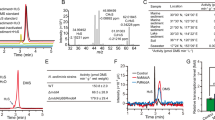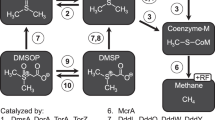Abstract
METHANE THIOL (methyl mercaptan, MeSH), its oxidation product, dimethyl disulphide (DMDS), and dimethyl sulphide (DMS) are naturally occurring metabolites. They are also produced by paper mills using the kraft pulp process1 and cause an industrial odour problem because of their low odour threshold. Although the biological production of these compounds is fairly well understood2, little is known about their biological decomposition. We report here that microbial populations present in anaerobic freshwater sediments and in anaerobic sewage digestor sludge are capable of metabolising the carbon in these volatile organic sulphur compounds to methane and carbon dioxide. Therefore, anaerobic habitats may serve as sinks in the biogeochemical cycling of these compounds.
This is a preview of subscription content, access via your institution
Access options
Subscribe to this journal
Receive 51 print issues and online access
$199.00 per year
only $3.90 per issue
Buy this article
- Purchase on Springer Link
- Instant access to full article PDF
Prices may be subject to local taxes which are calculated during checkout
Similar content being viewed by others
References
Sivela, S. & Sundman, V. Archs Microbiol. 103, 303–304 (1975).
Kadota, H. & Ishida, Y. A. Rev. Microbiol. 26, 127–138 (1972).
Challenger, R. Adv. Enzym. 12, 429–450 (1951).
Lovelock, J. E., Maggs, R. J. & Rasmussen, R. A. Nature, 237, 452–453 (1972).
Zinder, S. H. & Brock, T. D. Appl. environ. Microbiol. 35, 344–352 (1978).
Nelson, D. R. & Zeikus, J. G. Appl. Microbiol. 28, 258–261 (1974).
Kluyver, A. J. & Schnellen, C. B. T. P. Archs Biochem. 14, 57–70 (1947).
Zeikus, J. G. & Winfrey, M. R. Appl. environ. Microbiol. 31, 99–107 (1976).
Winfrey, M. R. & Zeikus, J. G. Appl. environ. Microbiol. 33, 275–281 (1977).
Bauchop, T. J. Bact. 94, 171–175 (1967).
Balch, W. E. & Wolfe, R. S. Appl. environ. Microbiol. 32, 781–791 (1976).
Thauer, R. K., Jungermann, K. & Decker, K. Bact. Rev. 41, 100–180 (1977).
Weast, R. C. (ed.) Handbook of Chemistry and Physics, 49th ed. (CRC Press Cleveland, 1968).
Author information
Authors and Affiliations
Rights and permissions
About this article
Cite this article
ZINDER, S., BROCK, T. Production of methane and carbon dioxode from methane thiol and dimethyl sulphide by anaerobic lake sediments. Nature 273, 226–228 (1978). https://doi.org/10.1038/273226a0
Received:
Accepted:
Issue Date:
DOI: https://doi.org/10.1038/273226a0
This article is cited by
-
A novel pathway producing dimethylsulphide in bacteria is widespread in soil environments
Nature Communications (2015)
-
Production of dimethylsulphide during the seasonal anoxia off Goa
Biogeochemistry (2012)
Comments
By submitting a comment you agree to abide by our Terms and Community Guidelines. If you find something abusive or that does not comply with our terms or guidelines please flag it as inappropriate.



